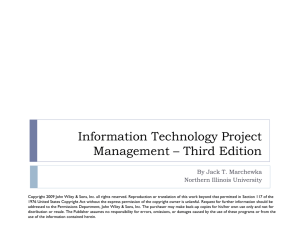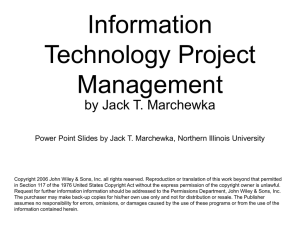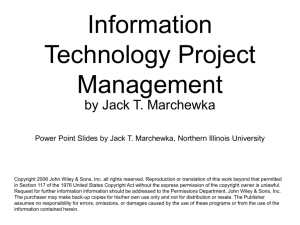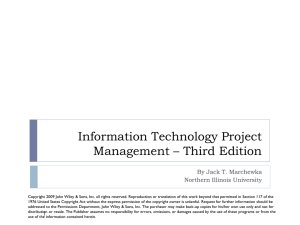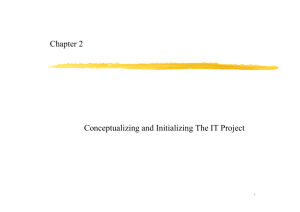Chapter 2: Initializing and Conceptualizing the IT Project
advertisement
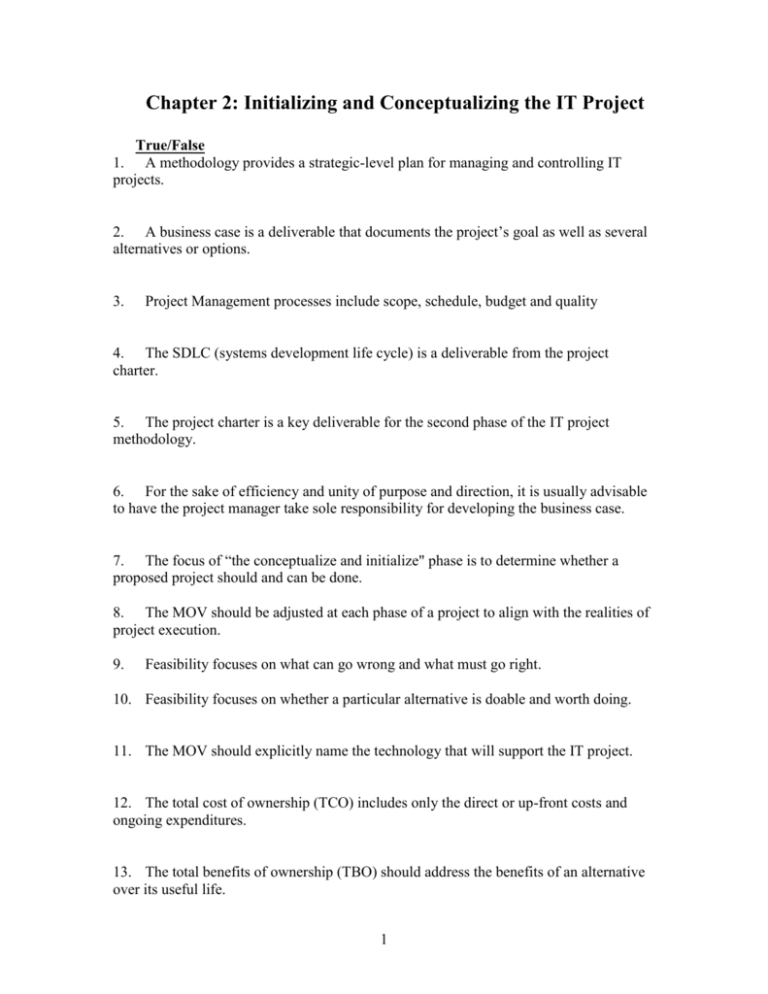
Chapter 2: Initializing and Conceptualizing the IT Project True/False 1. A methodology provides a strategic-level plan for managing and controlling IT projects. 2. A business case is a deliverable that documents the project’s goal as well as several alternatives or options. 3. Project Management processes include scope, schedule, budget and quality 4. The SDLC (systems development life cycle) is a deliverable from the project charter. 5. The project charter is a key deliverable for the second phase of the IT project methodology. 6. For the sake of efficiency and unity of purpose and direction, it is usually advisable to have the project manager take sole responsibility for developing the business case. 7. The focus of “the conceptualize and initialize" phase is to determine whether a proposed project should and can be done. 8. The MOV should be adjusted at each phase of a project to align with the realities of project execution. 9. Feasibility focuses on what can go wrong and what must go right. 10. Feasibility focuses on whether a particular alternative is doable and worth doing. 11. The MOV should explicitly name the technology that will support the IT project. 12. The total cost of ownership (TCO) includes only the direct or up-front costs and ongoing expenditures. 13. The total benefits of ownership (TBO) should address the benefits of an alternative over its useful life. 1 14. A significant deficiency of the payback method of analyzing alternatives is the failure to account for the time value of money. 15. All cash flows over the useful life of a project alternative must be included in the payback method of analysis. 16. The net present value method of project valuation takes into account all relevant cash flows as well as the company’s required rate of return. 17. The answer to a breakeven analysis is almost always expressed in a currency metric. 18. Scoring models are useful because they allow for the inclusion of qualitative factors. 19. Selecting multiple risky projects that have low correlation to each other can result in a portfolio of projects whose overall risk is lower than the individual project’s risk. 20. The Balance Scorecard approach employs four perspectives for analyzing project benefits: Financial Perspective, Customer Perspective, Competitor Perspective, and Internal Processes Perspective. 2 Multiple Choice 1. An Information Technology Project Methodology (ITPM) a) is an alternative metric for deciding between competing projects. b) is a six-phase program described by PMBOK and is offered as a generally accepted industry practice. c) is specified by parameters of the business case. d) is a set of deliverables derived from the various PLC phases. e) is a strategic-level plan for managing and controlling IT projects. Answer: 2. Scope and schedule are examples of: a) b) c) d) e) Project Management processes. Project Management tools. PMBOK areas of knowledge. Project Management objectives. Project Management infrastructure. Answer: 3. The first stage of the IT project methodology focuses on: a) b) c) d) e) choosing the project team members. defining the overall goal of the project. conceptualizing alternative approaches to project development. identifying the project's scope. identifying project managers and sponsors. Answer: 4. The project charter is a key deliverable from ________ and addresses ________: a) b) c) d) e) phase 1, How long will this project take? phase 1, Who is the project sponsor? phase 2, What scope controls will be used? phase 2, How much will the project cost? phase 3, Is there a detailed risk plan? Answer: 3 5. The _________ gives authority to the project manager to begin carrying out the processes and tasks associated with the systems development life cycle . a) b) c) d) e) business case project sponsor initiating process implementation plan project charter Answer: 6. The IT project management foundation includes all of the following except: a) b) c) d) e) PM processes PM objectives PM methodologies PM tools PMBOK knowledge areas Answer: 7. Which of the following statements about the business case is NOT true: a) A business case provides an analysis of feasibility. b) A business case provides senior management with sufficient information to fund a project. c) A business case provides details of possible impacts, costs and benefits. d) A business case provides a project budget. e) A business case may be a large formal document. Answer: 8. The Business case is the key deliverable for: a) b) c) d) e) phase 1. phase 2. phase 3. phase 4. phase 5. Answer: 4 9. Which of the following was NOT given as a reason for recruiting a core team to develop the business case? a) b) c) d) e) enhanced credibility alignment with organizational goals access to real costs early identification of project team shared sense of ownership Answer: 10. The overall goal and measure of project success is: a) b) c) d) e) the project's MOV. the project's NPV. the project's technical competency. the project's adherence to budget and schedule. the project's end-user acceptance. Answer: 11. All of the following are steps in developing the project MOV except: a) b) c) d) e) Identify the available organizational resources. Identify the desired value of the IT project. Develop an appropriate metric. Set a time frame for achieving MOV. Verify and get agreement from project stakeholders. Answer: 12. Which of the following statements is the best indicator that the new software project was successful? a) The project's product, a software system, was enthusiastically accepted by 100% of the end users who were able to begin using it after completing only a one-day training session. b) The project's product, a software system, was a week late and 2% over budget, but six months later was found to have met the company's goal of reducing service callbacks by 15%. c) The project's product, a software system, was completed two weeks ahead of time freeing up the entire development team to begin work on other projects. d) The project's product, a software system, was completed right on schedule and was delivered $10,000 under the $100,000 budget allocation. e) The project's product, a software system, was completed on time and on budget and was tested and shown to be 100% bug-free. 5 Answer: 13. Which of the following is the best MOV statement? a) Our project should make Dayton customers flock to the stores in droves to buy our products. b) Our project should be completed in no more than 180 days and should cost no more than $150,000 and be completed 100% in-house. c) Our project should increase sales in the Dayton market by 15% next year to complete our company's Ohio expansion strategy. d) Our project should utilize the Spiral Development approach to eliminate 95% of the major risks to our Dayton sales program. e) Our project should produce an advertising campaign in Dayton that wins the Ohio Advertising Guild's Award for most creative campaign. Answer: 14. A company utilizes the payback method exclusively to select projects. Which of the following mutually exclusive (they can only do one of them) projects will they choose? (Assume cash flows occur in equal monthly installments). a) Initial Investment: $10,000 Net Cash Flows: year 1:$0 year 2:$120,000 year 3:$60,000 each year thereafter:$60,000 b) Initial Investment:$100,000 Net Cash Flows: year 1:$50,000 year 2:$50,000 year 3:$100,000 each year thereafter:$1,000,000 c) Initial Investment:$10,000 Net Cash Flows: year 1:0 year 2:$100,000 year 3:$100,000 each year thereafter:$100,000 d) Initial Investment:$100,000 Net Cash Flows: year 1:$1,000,000 year 2:$2,000,000 year 3:$2,000,000 each year thereafter:0 e) Initial Investment:$10,000 Net Cash Flows: year 1:$8,000 year 2:$12,000 year 3:$120,000 each year thereafter:$120,000 Answer: 15. How many widgets would a company have to sell if their initial investment was $60,000 and widgets sold for $25? Materials to produce 100 widgets cost $1000. Direct labor costs $2.50 per widget. Total indirect costs and overhead is 10% of the selling price. a) b) c) d) e) 4,800 6,000 8,000 8,142 Not enough information to calculate. 6 Answer: b 16. Calculate the ROI for a project with total expected costs of $40,000 and total expected benefits of 35,000. a) b) c) d) e) -12.5% 12.5% 1.875% 187.5% -18.75% Answer: 17. Calculate the Net Present Value for a project with the following cash flows: Year 0: ($5,000) Year 1: $10,000 Year 2: $10,000 Year3: ($2,000). The discount rate is 5% a) b) c) d) e) $19,209.75 $14,209.75 $18,840.25 $23,840.25 $12,350.00 Answer: 18. Trying to decide between three alternatives, a company employed a scoring model. Three criteria were chosen. Criteria A was believed to be the most important and was given a weight of 50%. The other two were deemed to be equal to each other in importance. A relative scoring range of 0 to 10 was used. The table below shows each alternative and their scores. Which alternative should the company choose? Criteria Alternative A Alternative B Alternative C A 5 6 7 B 8 7 7 C 8 8 5 a) b) c) d) e) Choose alternative A Choose alternative B Choose alternative C Choose either alternative A or B Choose either alternative A or C Answer: 19. Which of the following is NOT a perspective from the Balanced Scorecard Approach?: 7 a) b) c) d) e) Financial Perspective Internal Processes Perspective Innovation & Learning Perspective Customer Perspective Organizational Value Perspective Answer: 20. The text cites all of the following as reasons supporting the selection of an IT project except: a) The project's covariance with other projects leads to a reduction in the overall project portfolio risk. b) The project maps directly to the organization's strategies and goals c) The project provides measurable organizational value. d) The project represents a cutting edge technology that fits the team skill set. e) The project ranks favorably based on the companies adaptation of the Balanced Scorecard Approach. Answer: 8 Short Answer Questions (From End of Chapter Review Questions) 1. What are the advantages of having and following a project methodology? . 2. Describe the five phases of the IT project methodology. 3. Why is it important to have deliverables for each phase of the IT project methodology? 4. How can the experiences of and lessons learned by past project team members be incorporated into a project methodology? 5. Describe the “conceptualize and initialize phase” of the IT project methodology. 6. What is a project charter? 7. What are the advantages of developing a detailed project plan after a project has been approved for funding? 8. Describe the “execute and control phase” of the IT project methodology. 9. Describe the “close project phase” of the IT project methodology. 10. Describe the “evaluate project success phase” of the IT project methodology. 11. Describe the five project management processes. 12. Why can a project that is developed under budget and before its deadline still not be considered successful? 13. What are tools needed to support an IT project? 14. How does an organizational infrastructure support a project? 9 15. What is a project infrastructure? 16. Describe a technical infrastructure that would be needed to support a consulting team working at a client site. 17. Discuss how the project management knowledge areas support the IT project methodology. 18. What is a business case? 19. Why should an organization develop a business case? 20. What is the purpose of selecting a core team to develop a business case? 21. What is a project’s measurable organizational value (MOV)? 22. Develop a MOV for an organization that is contemplating developing a corporate intranet. 23. Why must a project’s MOV be agreed upon? 24. Describe how a project’s MOV can support an organization’s goals and strategies. 25. Describe how an IT project can bring value to an organization. 26. What is a base case alternative? Why should a business case even consider a base case alternative? 27. Describe Economic Feasibility. 10 28. Describe Technical Feasibility. 29. Describe Organizational Feasibility. 30. What other types of feasibility issues should an organization consider? 31. How should the risk of each business case alternative be analyzed? 32. What is Total Cost of Ownership? 33. What is Total Benefits of Ownership? 34. What is the difference between tangible and intangible benefits? Give an example of each. 35. What are some ways of quantifying intangible benefits? 36. Describe the payback method. What are some advantages and disadvantages of this method? 37. Describe the breakeven method. What are some advantages and disadvantages of this method? 38. Describe the ROI method. What are some advantages and disadvantages of this method? 39. Describe the NPV method. What are some advantages and disadvantages of this method? 40. What effect does increasing the discount rate have on a project’s NPV? 41. What are the advantages of using a scoring model when comparing several project alternatives? Any disadvantages? 11 42. What is an IT project portfolio? 43. Why shouldn’t an organization always take on less challenging projects? 44. Describe the criteria that should be used to make a project selection decision. 45. Describe the Balanced Scorecard approach. 46. Describe the financial perspective of the Balanced Scorecard approach. 47. Describe the customer perspective of the Balanced Scorecard approach. 48. Describe the internal process perspective of the Balanced Scorecard approach. 49. Describe the innovation and learning perspective of the Balanced Scorecard approach. 50. How does the concept of MOV support the Balanced Scorecard approach? 12 Essay Questions 1. Define an IT project methodology and describe its phases. 2. What is the purpose of a project charter? 3. Define, compare and contrast project management processes and project-oriented processes. 4. Describe at least four reasons that the text gives for undertaking an IT project. 5. What is the purpose of a Business Case and what are the characteristics of a good Business Case? 6. What is Measurable Organizational Value (MOV) and what are the four major characteristics of a good MOV? 7. The text discusses numerous aspects of feasibility. Name and define three of them. 8. There are numerous financial models for analyzing the benefits from a project. Among those models discussed in the chapter are payback, breakeven, return on investment (ROI), net present value (NPV) and scoring models. What are the strengths and weaknesses of each approach to analyzing value? 9. Described the Balanced Scorecard Approach and list at least three significant reasons why it can fail as an analysis tool. 10. What are the three infrastructures that are needed to support the IT project? Describe the components of each of the infrastructures. 13
